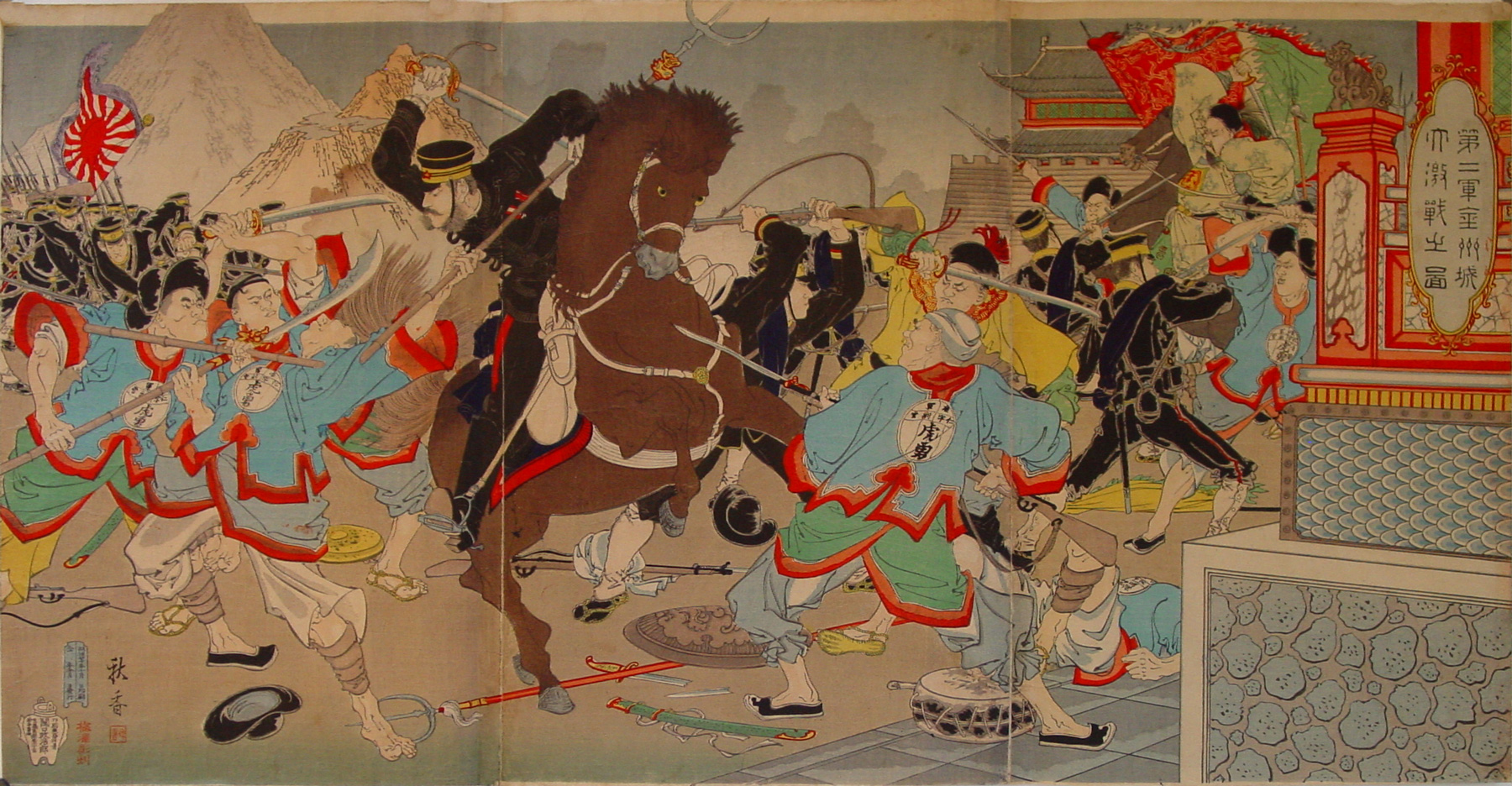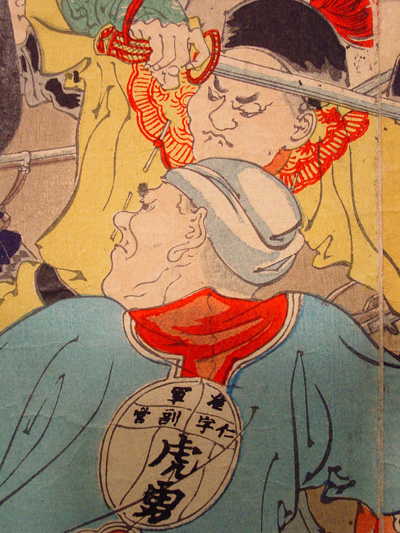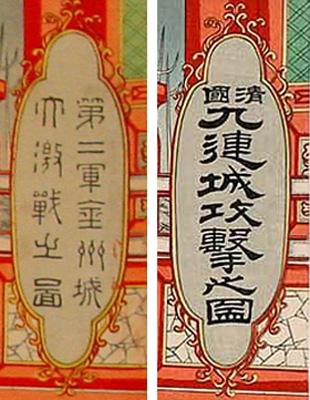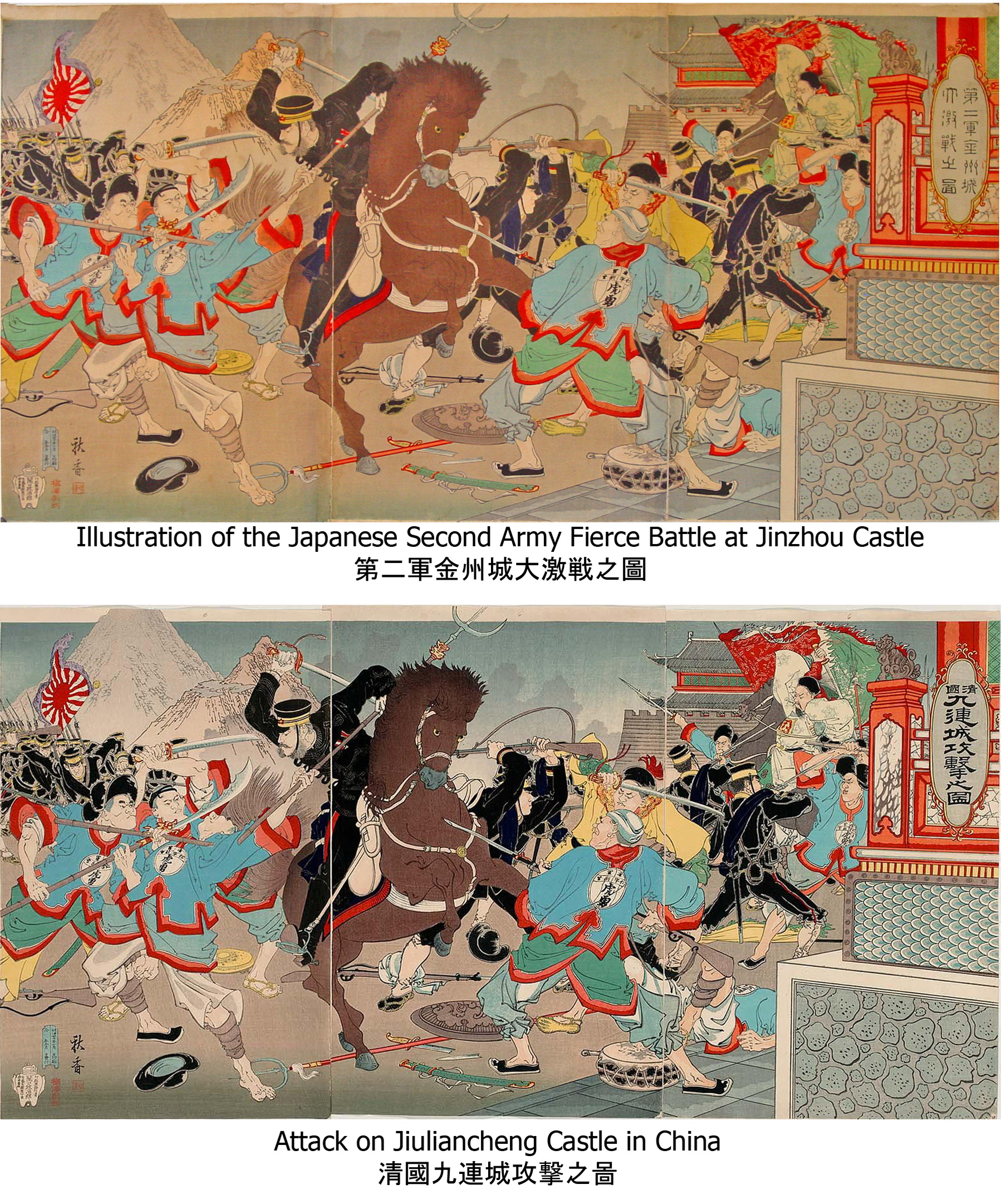About This Print
The Second Army and the Battle of Jinzhou [Chinchou]
Source: Impressions of the Front: Woodcuts of the Sino-Japanese War, Shunpei Okamoto, Philadelphia Museum of Art, 1983, p. 14.On September 26, 1894, the Japanese imperial headquarters had organized the Second Army. Its objective was to conquer the Chinese dockyard and arsenal of Port Arthur and then to embark on a campaign into the Peking region after winter. On October 24, while the First Army was crossing the Yalu River and entering China, the Second Army landed on on the Liaotung (Chinchou) Peninsula. By November 3, the Second Army advanced toward Chinchou, the major stronghold before Port Arthur. With a full-scale assault on November 6, the Second Army broke the stiff resistance at Chinchou, taking the fortress before noon.
Source: Impressions of the Front: Woodcuts of the Sino-Japanese War, Shunpei Okamoto, Philadelphia Museum of Art, 1983, p. 35.
Twenty-five-year-old Nanbu Kijiro, a second artillery lieutenant (better known as the inventor of the Nanbu rifle and machine gun), described what he saw as platoon commander of the Third Mountain Artillery Battalion during the battle of Chinchou: "The battleground smelled of blood. deep craters remained where shells had flung earth into the sky. Trees and rooftops were strewn all over. The odors of blood and powder lingered. Our fallen comrades had been laid out in front of grave makers made of available wood. The area in front of these temporary graves was swept so clean it touched my heart. I prayed there silently."
Private First-Class Kubota Chuzo, a twenty-one-year-old farmer, wrote in his war diary: "Today our company had lunch in the southern section of Chinchou. Chinese corpses were piled everywhere.... Some enemy soldiers were found among the dead feigning death. Our litter corps found them and slashed or stabbed them to death."
Treating the Enemy with A Measure of Respect
This is one of a relatively small number of Sino-Japanese War prints that depict the Chinese as worthy adversaries. The Chinese soldiers' facial features are not caricatured, as they are in so many war prints, and they wear a look of determination and resolve. The two larger characters on the back of the Chinese fighter read 虎勇 Brave Tigers.
The Same Print - Two Different Battles
Publishers were always looking for ways to cut costs. One way was to re-purpose a popular war print design to illustrate another battle. In most instances of re-purposing, only part of the design was reused, or modifications were made to an earlier design to represent a different battle, but in this case the prints are identical except for the title cartouches in the upper right of each print. The prints illustrate different battles that occurred during the same time frame, both involving castles, but in locations about 400 km apart.
Print Details
| IHL Catalog | #306 |
| Title or Description | Illustration of the Japanese Second Army Fierce Battle at Jinzhou Castle Dai ni gun Kinshūjō daigekisen no zu 第二軍金州城大激戦之 |
| Artist | Nakamura Shūkō (active c. 1894-1904) |
| Signature |  |
| Seal | Shūkō 秋香 [as shown above] |
| Publication Date | October 1894 (Meiji 27) |
| Publisher | 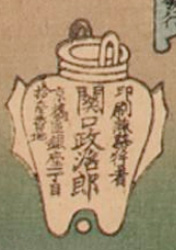 [Marks: pub. ref. 462; seal not shown] |
| Carver |  |
| Impression | excellent |
| Colors | excellent |
| Condition | good - trimmed but top margin intact; panel joined; vertical folds where panels are joined; some soiling and wrinkling |
| Genre | ukiyo-e; senso-e (Sino-Japanese War) |
| Miscellaneous | |
| Format | vertical oban triptych |
| H x W Paper | 14 1/4 x 28 1/2 in. (36.2 x 72.4 cm) |
| Literature | Impressions of the Front: Woodcuts of the Sino-Japanese War, Shunpei Okamoto, Philadelphia Museum of Art, 1983, p. 35. pl. 52; Japan Awakens: Woodblock Prints of the Meiji Period (1868-1912), Barry Till, Pomegranate Communications, Inc., 2008, p. 37. |
| Collections This Print | Philadelphia Museum of Art 1976-75-190a-c; Museum of Fine Arts Boston RES.23.294-296; Smithsonian National Museum of Asian Art S1999.52a-c; Art Gallery of Greater Victoria 2004.026.055; Jordan Schnitzer Museum of Art, University of Oregon 1984:3.9a-c |
last revision:
4/28/2020
3/13/2020


